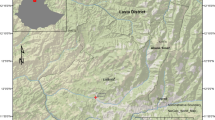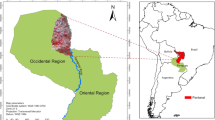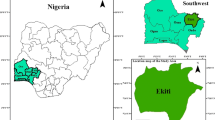Abstract
Globally, land cover change poses a serious threat to biodiversity and climate change. Anthropogenic actions have been the dominant force among all natural and human forces shaping the Land use and Land cover, causing dramatic changes to the global Landuse and Land cover. The Rajparian Wildlife Sanctuary in the Kashmir Himalayas has undergone substantial changes over the past few decades, but lacks extensive assessment. A multispectral remotely sensed dataset was used to assess changes in land use and land cover of the Sanctuary over almost 27 years (1993–2021). A maximum likelihood algorithm was used to classify Landsat images for the years 1993, 2006, and 2021 and geometric correction were rectified in Earth Resources Data Analysis System (2014) software. The results of the present study indicate that the study area has undergone major changes between 1993 and 2020. Forest and snow-covered areas have shrunk, while non-forested areas like grassland, barren, scrub, built-up areas, and river beds have shown positive growth in the sanctuary. Within the studied time period, a total loss of 5.9 km2 was recorded for the forest areas and 1.5 km2 for the snow covered areas. The main threats driving the Land use and Land cover change in the Sanctuary were grazing pressure, natural resource exploitation, poaching, and development projects. The results of this study may potentially provide information to planners, and decision-makers for the sustainable management of natural resources and implementing important management decisions in order to preserve the rich biodiversity of the Sanctuary.





Similar content being viewed by others
Data availability
The datasets generated during and/or analyzed during the current study are not publicly available due to privacy restrictions but can be made available from the corresponding author upon reasonable request.
References
Agarwala, M., DeFries, R. S., Qureshi, Q., & Jhala, Y. V. (2016). Changes in the dry tropical forests in Central India with human use. Regional Environmental Change, 16(1), 5–15.
Ahmad, F., ul Hassan, Z., Farooq, S., & Shah, J. A. (2015). Assessments of land use/land cover change in Hirpora Wildlife Sanctuary, Kashmir. Asian Journal of Earth Sciences, 8(3), 64–73.
Aneaus, S., Rashid, I., Srivastava, P. K., & Charoo, S. A. (2023). Quantifying the landscape changes within and outside the Dachigam National Park, Kashmir Himalaya, India using observations and models. Environmental Monitoring and Assessment, 195(10), 1139.
Batar, A. K., Watanabe, T., & Kumar, A. (2017). Assessment of land-use/land-cover change and forest fragmentation in the Garhwal Himalayan Region of India. Environments, 4(2), 34.
Batunacun, Nendel, C., Hu, Y., & Lakes, T. (2018). Land‐use change and land degradation on the Mongolian Plateau from 1975 to 2015—A case study from Xilingol, China. Land Degradation & Development, 29(6), 1595-1606. https://doi.org/10.1002/ldr.2948
Bhat, A. H., Mir, A. H., & Charoo, S. A. (2022). Study of avifauna of rajparian wildlife sanctuary, Kashmir Himalaya: Diversity, Status And Seasonal Variation. Journal of Mountain Research, 17(1), 137–151.
Bhat, A. H., Mir, A. H., & Charoo, S. A. (2023a). Influence of habitat heterogeneity on avian diversity in the Rajparian Wildlife Sanctuary, Kashmir Himalaya. The Journal of Basic and Applied Zoology, 84(1), 1–11.
Bhat, A. H., Mir, A. H., & Charoo, S. A. (2023b). Influence of habitat heterogeneity on the elevational distribution and guild structure of birds in the Rajparian Wildlife Sanctuary, Kashmir Himalaya. Ornithology Research, 31(1), 51–61.
Bhat, B. A., Ahmad, R., Fazili, M. F., Haq, I. U., & Bhat, G. A. (2020). Threatened fauna of Jammu and Kashmir state. Biodiversity of the Himalaya: Jammu and Kashmir State, 997–1009.
Caravaggio, N. (2020). A global empirical re-assessment of the Environmental Kuznets curve for deforestation. Forest Policy and Economics, 119, 102282. https://doi.org/10.1016/j.forpol.2020.102282
Chakravarty, S., Ghosh, S. K., Suresh, C. P., Dey, A. N., & Shukla, G. (2012). Deforestation: Causes, effects and control strategies. Global Perspectives on Sustainable Forest Management, 1, 1–26. https://doi.org/10.5772/33342
Congalton, R. G. (1991). A review of assessing the accuracy of classifications of remotely sensed data. Remote Sensing of Environment, 37(1), 35–46.
Dendup, P., Wangdi, L., Jamtsho, Y., Kuenzang, P., Gyeltshen, D., Tashi, T., & Tshering, B. (2021). Bird diversity and conservation threats in JigmeDorji National Park, Bhutan. Global Ecology and Conservation, 30, e01771.
Fagan, M. E., Reid, J. L., Holland, M. B., Drew, J. G., & Zahawi, R. A. (2020). How feasible are global forest restoration commitments? Conservation Letters, 13(3), e12700. https://doi.org/10.1111/conl.12700
Fayaz, A., Shafiq, M. U., Singh, H., & Ahmed, P. (2020). Assessment of spatiotemporal changes in land use/land cover of North Kashmir Himalayas from 1992 to 2018. Modeling Earth Systems and Environment, 6, 1189–1200.
Fayaz, A., Shafiq, M. U., Singh, H., & Ahmed, P. (2020). Assessment of spatiotemporal changes in land use/land cover of North Kashmir Himalayas from 1992 to 2018. Modeling Earth Systems and Environment, 6, 1189–1200.
Ganaie, T. A., Sahana, M., & Hashia, H. (2018). Assessing and monitoring the human influence on water quality in response to land transformation within Wular environs of Kashmir Valley. Geo Journal, 83, 1091–1113.
Ganaie, T. A., Jamal, S., & Ahmad, W. S. (2021a). Changing land use/land cover patterns and growing human population in Wular catchment of Kashmir Valley, India. Geo Journal, 86, 1589–1606.
Ganaie, T. A., Tali, J. A., ul Shafiq, M., Singh, H., & Ahmed, P. (2021). Mapping Seasonal Variability and Spatio‐Temporal Trends of Water Quality Parameters in Wular Lake (Kashmir Valley). Geographic Information Science for Land Resource Management, 161–190
Gounaridis, D., Symeonakis, E., Chorianopoulos, I., & Koukoulas, S. (2018). Incorporating density in spatiotemporal land use/cover change patterns: The case of Attica, Greece. Remote Sensing, 10(7), 1034. https://doi.org/10.3390/rs10071034
Iftekhar, M. S., & Hoque, A. F. (2005). Causes of forest encroachment: An analysis of Bangladesh. GeoJournal, 62, 95–106. https://doi.org/10.1007/s10708-005-7917-z
Islam, K., Jashimuddin, M., Nath, B., & Nath, T. K. (2018). Land use classification and change detection by using multi-temporal remotely sensed imagery: The case of Chunati wildlife sanctuary, Bangladesh. The Egyptian Journal of Remote Sensing and Space Science, 21(1), 37–47. https://doi.org/10.1016/j.ejrs.2016.12.005
Islam, M. R., Khan, M. N. I., Khan, M. Z., & Roy, B. (2021). A three decade assessment of forest cover changes in Nijhum dwip national park using remote sensing and GIS. Environmental Challenges, 4, 100162. https://doi.org/10.1016/j.envc.2021.100162
Lambin, E. F., Turner, B. L., Geist, H. J., Agbola, S. B., Angelsen, A., Bruce, J. W., ... & Xu, J. (2001). The causes of land-use and land-cover change: Moving beyond the myths. Global Environmental Change, 11(4), 261–269.
Lizarazo, I. (2014). Accuracy assessment of object-based image classification: Another STEP. International Journal of Remote Sensing, 35(16), 6135–6156.
Lone, S. A., & Mayer, I. A. (2019). Geo-spatial analysis of land use/land cover change and its impact on the food security in District Anantnag of Kashmir Valley. GeoJournal, 84, 785–794.
Malik, M. I. (2012). Analysis of population growth and land use change in Anantnag town of South Kashmir using remote sensing and geographical information system. Journal of Experimental Sciences, 3(5), 23–27.
Mamnun, M., & Hossen, S. (2020). Spatio-temporal analysis of land cover changes in the evergreen and semi-evergreen rainforests: A case study in Chittagong Hill Tracts, Bangladesh. International Journal of Forestry, Ecology and Environment, 2(2), 87–99. https://doi.org/10.18801/ijfee.020220.10
Misra, S., Maikhuri, R. K., Kala, C. P., Rao, K. S., & Saxena, K. G. (2008). Wild leafy vegetables: A study of their subsistence dietetic support to the inhabitants of Nanda Devi Biosphere Reserve, India. Journal of Ethnobiology and Ethnomedicine, 4, 1–9.
Oluwajuwon, T. V., Alo, A. A., Ogana, F. N., & Adekugbe, O. A. (2021). Forest cover dynamics of a lowland rainforest in southwestern Nigeria using GIS and remote sensing techniques. Journal of Geographic Information System, 13(2), 83–97.
Pandit, M. K., Sodhi, N. S., Koh, L. P., Bhaskar, A., & Brook, B. W. (2007). Unreported yet massive deforestation driving loss of endemic biodiversity in Indian Himalaya. Biodiversity and Conservation, 16, 153–163.
Rasool, R., Fayaz, A., ul Shafiq, M., Singh, H., & Ahmed, P. (2021). Land use land cover change in Kashmir Himalaya: Linking remote sensing with an indicator based DPSIR approach. Ecological Indicators, 125, 107447.
Rawat, J. S., & Kumar, M. (2015). Monitoring land use/cover change using remote sensing and GIS techniques: A case study of Hawalbagh block, district Almora, Uttarakhand, India. The Egyptian Journal of Remote Sensing and Space Science, 18(1), 77–84. https://doi.org/10.1016/j.ejrs.2015.02.002
Reza, A. A., & Hasan, M. K. (2019). Forest biodiversity and deforestation in Bangladesh: The latest update. Forest Degradation Around the World, 1–19.
Romijn, E., Lantican, C. B., Herold, M., Lindquist, E., Ochieng, R., Wijaya, A., ... & Verchot, L. (2015). Assessing change in national forest monitoring capacities of 99 tropical countries. Forest Ecology and Management, 352, 109–123. https://doi.org/10.1016/j.foreco.2015.06.003
Sangermano, F., Toledano, J., & Eastman, J. R. (2012). Land cover change in the Bolivian Amazon and its implications for REDD+ and endemic biodiversity. Landscape ecology, 27, 571–584. https://doi.org/10.1007/s10980-012-9710-y
Shafiq, M. U., Ramzan, S., Ahmed, P., Mahmood, R., & Dimri, A. P. (2019). Assessment of present and future climate change over Kashmir Himalayas, India. Theoretical and Applied Climatology, 137, 3183–3195.
Sharma, E., Molden, D., Wester, P., & Shrestha, R. M. (2016). The Hindu Kush Himalayan monitoring and assessment programme: Action to sustain a global asset. Mountain Research and Development, 36(2), 236–239.
Turner, B. L. (1994). Local faces, global flows: The role of land use and land cover in global environmental change. Land Degradation & Development, 5(2), 71–78. https://doi.org/10.1002/ldr.3400050204
Verburg, P. H., & Chen, Y. (2000). Spatial explorations of land use change and grain production in China. Agriculture, Ecosystems & Environment, 82(1–3), 333–354. https://doi.org/10.1016/S0167-8809(00)00236-X
Acknowledgements
The authors highly acknowledge all the persons who helped to carry out the research especially Nisar Ahmad, Zubair Ahmad and Muzamil ahmad. We are thankful to the Department of Remote sensing and environment for their help in completing the research.
Funding
The study was self financed.
Author information
Authors and Affiliations
Corresponding author
Ethics declarations
Ethics approval and consent to participate
Not required.
Conflict of interests
The authors declare that they have no conflict of interests.
Additional information
Publisher's Note
Springer Nature remains neutral with regard to jurisdictional claims in published maps and institutional affiliations.
Rights and permissions
Springer Nature or its licensor (e.g. a society or other partner) holds exclusive rights to this article under a publishing agreement with the author(s) or other rightsholder(s); author self-archiving of the accepted manuscript version of this article is solely governed by the terms of such publishing agreement and applicable law.
About this article
Cite this article
Bhat, A.H., Bhat, T.A. & Mir, A.H. Assessing the trends of land cover dynamics and its major driving forces in the Rajparian Wildlife Sanctuary Kashmir, Himalaya. GeoJournal 89, 101 (2024). https://doi.org/10.1007/s10708-024-11109-3
Accepted:
Published:
DOI: https://doi.org/10.1007/s10708-024-11109-3




